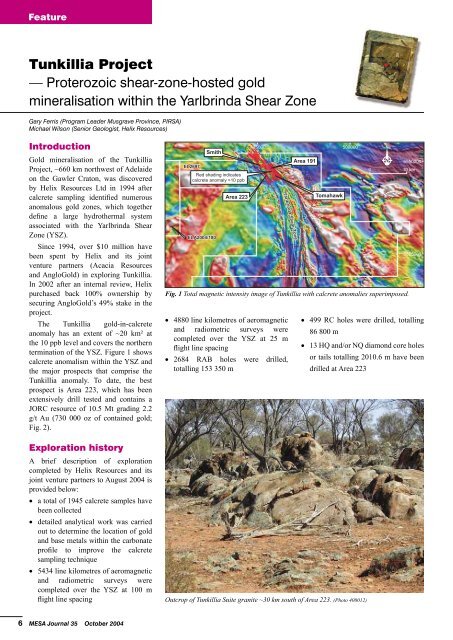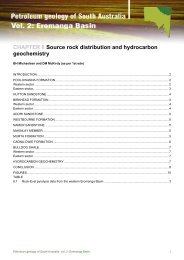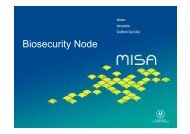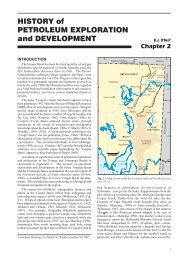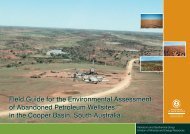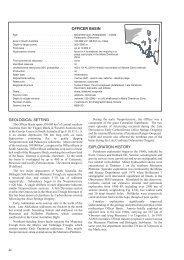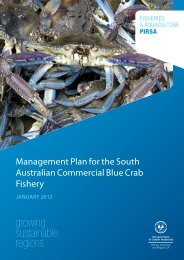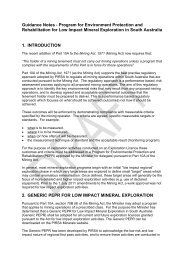Tunkillia Project - Proterozoic shear-zone-hosted gold ... - MISA
Tunkillia Project - Proterozoic shear-zone-hosted gold ... - MISA
Tunkillia Project - Proterozoic shear-zone-hosted gold ... - MISA
- No tags were found...
You also want an ePaper? Increase the reach of your titles
YUMPU automatically turns print PDFs into web optimized ePapers that Google loves.
Feature<strong>Tunkillia</strong> <strong>Project</strong>— <strong>Proterozoic</strong> <strong>shear</strong>-<strong>zone</strong>-<strong>hosted</strong> <strong>gold</strong>mineralisation within the Yarlbrinda Shear ZoneGary Ferris (Program Leader Musgrave Province, PIRSA)Michael Wilson (Senior Geologist, Helix Resources)IntroductionGold mineralisation of the <strong>Tunkillia</strong><strong>Project</strong>, ~660 km northwest of Adelaideon the Gawler Craton, was discoveredby Helix Resources Ltd in 1994 aftercalcrete sampling identified numerousanomalous <strong>gold</strong> <strong>zone</strong>s, which togetherdefine a large hydrothermal systemassociated with the Yarlbrinda ShearZone (YSZ).Since 1994, over $10 million havebeen spent by Helix and its jointventure partners (Acacia Resourcesand AngloGold) in exploring <strong>Tunkillia</strong>.In 2002 after an internal review, Helixpurchased back 100% ownership bysecuring AngloGold’s 49% stake in theproject.The <strong>Tunkillia</strong> <strong>gold</strong>-in-calcreteanomaly has an extent of ~20 km² atthe 10 ppb level and covers the northerntermination of the YSZ. Figure 1 showscalcrete anomalism within the YSZ andthe major prospects that comprise the<strong>Tunkillia</strong> anomaly. To date, the bestprospect is Area 223, which has beenextensively drill tested and contains aJORC resource of 10.5 Mt grading 2.2g/t Au (730 000 oz of contained <strong>gold</strong>;Fig. 2).Exploration historyA brief description of explorationcompleted by Helix Resources and itsjoint venture partners to August 2004 isprovided below: a total of 1945 calcrete samples havebeen collected detailed analytical work was carriedout to determine the location of <strong>gold</strong>and base metals within the carbonateprofile to improve the calcretesampling technique 5434 line kilometres of aeromagneticand radiometric surveys werecompleted over the YSZ at 100 mflight line spacingSmithEL2697Red shading indicatescalcrete anomaly >10 ppbELA2004/180Area 223Fig. 1 Total magnetic intensity image of <strong>Tunkillia</strong> with calcrete anomalies superimposed. 4880 line kilometres of aeromagneticand radiometric surveys werecompleted over the YSZ at 25 mflight line spacing 2684 RAB holes were drilled,totalling 153 350 m475000 500000Yarlbrinda Yarlbrinda Shear Shear Zone ZoneArea 191Tomahawk 499 RC holes were drilled, totalling86 800 m 13 HQ and/or NQ diamond core holesor tails totalling 2010.6 m have beendrilled at Area 223Outcrop of <strong>Tunkillia</strong> Suite granite ~30 km south of Area 223. (Photo 400012)65500000 10 km6525000202427_0146MESA Journal 35 October 2004
Feature 62.5 line kilometres of trial gravitysurvey on five lines have beenundertaken within the <strong>Tunkillia</strong>Prospect, and south over the YSZ a detailed gravity survey was carriedout over most of the <strong>Tunkillia</strong>Prospect detailed structural analysis ofdiamond drill core from Area 223(Hill and Standish, 2000; variousHelix quarterly reports to theAustralian Stock Exchange Ltd) a 70 line kilometre induced polarisationsurvey was completed overArea 223, Area 191 and Tomahawk ongoing co-operative studies byPIRSA, CRC-LEME, GeoscienceAustralia and the University ofAdelaide as part of the CentralGawler Craton <strong>Project</strong>.Host rocksHost rocks to the <strong>Tunkillia</strong> <strong>Project</strong> areaare medium to coarse-grained granitoidsof the <strong>Tunkillia</strong> Suite (L 1and L 2),that have been intensely <strong>shear</strong>ed andbrecciated within the YSZ. An idealisedsection through <strong>Tunkillia</strong> is presented inFigure 3.Gold is <strong>hosted</strong> in narrow, steeplydipping quartz veins (lode <strong>gold</strong> style) andis associated with sulphides, dominantlypyrite with minor galena, within analteration <strong>zone</strong> comprising sericiteand chlorite. Some of the best <strong>gold</strong>intersections from Area 223 include: LRC012: 36 m at 3.68 g/t Au(including 14 m at 8.1 g/t) LRC037: 13 m at 5.47 g/t Au(including 4 m at 12.1 g/t) LRC237: 19 m at 5.60 g/t Au(including 4 m at 11.3 g/t) LRC033: 35 m at 2.37 g/t Au(including 3 m at 15.2 g/t) LRC232: 23 m at 4.03 g/t Au LRC414: 16 m at 5.61 g/t Au LRC498: 19 m at 6.49 g/t Au.Structural geology ofthe <strong>Tunkillia</strong> areaThe <strong>Tunkillia</strong> <strong>Project</strong> is located inthe northern part of the YSZ wherethe <strong>zone</strong> has been reorientated to thenorth-northwest. Outcrop is sparse andconfined to low, isolated outcrops southand west of <strong>Tunkillia</strong>, and patchy lowoutcrop along the vermin proof fenceto the northwest. Within the NuckullaHill area to the south, <strong>Tunkillia</strong> Suitegranitoids crop out at several locationsnorth and south of Childera Outstation.These rocks have undergone regionaldeformation within the <strong>shear</strong> <strong>zone</strong>,which has produced a range of fabrics(Fig. 4), from a regional north–south,to north-northwest–south-southeaststrikingfoliation with crosscuttingmylonite <strong>zone</strong>s. The main foliationstrikes between 285 and 340° (magneticnorth) and dips steeply to the southwest.The mylonite <strong>zone</strong>s strike north–southand dip steeply to the west.Gold mineralisation is <strong>hosted</strong> withinquartz–sulphide veins. Two generationsof veins are observed in drill core:1. V1 veins — quartz±sulphide(predominantly pyrite with minorgalena and sphalerite) veinswhich host mineralisation. Laing(1998) divided the V1 veins into a‘concordant to cleavage’ set and a‘discordant to cleavage’ set.2. V2 veins — barren calcite±quartz andchlorite veins that post-date regional<strong>shear</strong>ing (Fig. 3).The V1 vein set is sub-parallel to S 1which suggests that they were formedduring the main <strong>shear</strong>ing event. TheV2 vein set does not correlate well withthe S 1and V1 structural orientation; themain cluster strikes 026° and dips 32 ° tothe northeast (Standish et al., 1997).Pontifex and Hand (1997) reportedthat V1 veins sometimes display abranching structure, suggestive ofstockwork. The early veins havebeen overprinted by the myloniticdeformation. This is a characteristicfeature of mesothermal lode deposits thatshow cyclic changes in fluid pressuresfrom periods of lithostatic pressureto periods of sub-lithostatic to supralithostaticpressure (Cox et al., 1991).The vein network at <strong>Tunkillia</strong> is narrowand does not penetrate the wallrocks forany great distance. Mineralised <strong>zone</strong>sare therefore likely to have been <strong>zone</strong>sof high permeability and fluid flux atArea 223 North112000mNA$550 pit shellbased on Feb 2004resource111500mN111000mNArea 223South110000mEPrimary <strong>gold</strong> lodes (-100 mRL)Supergene lodeRC drillhole traceMafic dyke0 200 metresFig. 2 Area 223 drillhole location plan.202427_015near lithostatic pressure during veinformation and mineralisation.Alteration assemblageIn a regional context, the <strong>Tunkillia</strong> areashows evidence of extensive alteration.Large <strong>zone</strong>s of demagnetisation areobserved in aeromagnetic images,similar to the alteration described atNuckulla Hill (Parker, 2003). HelixResources NL defined a western andMESA Journal 35 October 2004 7
FeatureW50 m100150Bleached <strong>zone</strong>Augen gneiss (TAG)0 50 metresFig. 3 Generalised section of the Area 223 prospect.eastern demagnetised <strong>zone</strong> (alterationof primary magnetite to ilmenite) withinthe northern YSZ; Area 223 is locatedwithin the western demagnetised <strong>zone</strong>.This indicates that large volumes of fluidwere focused within the <strong>shear</strong> <strong>zone</strong>,particularly along the margins.At the prospect scale, <strong>gold</strong>mineralisation at <strong>Tunkillia</strong> is associatedwith <strong>zone</strong>s of intense sericitealteration, and quartz and sulphideveining. Petrology shows that primaryplagioclase grains have been extensivelyaltered to sericite. In hand specimen, thishas imparted a pale green-brown colourto the rock. Helix Resources has termedthe main alteration <strong>zone</strong> the CentralAlteration Zone (CAZ). The sericitealteration provides evidence for strainGrid North305°295°316°323°82.5°80-85°80-85°Dacite dyke (DAD)337°Magnetic North80-85°V2026°V1S1S2?Phyllitic <strong>shear</strong> (PUS)Fig. 4 Summary diagram of main structuralorientations from diamond drill core in Area223 (after Standish et al., 1997).32°202427_017Chlorite-sericitealteration <strong>zone</strong> (CAZ)Fine-grained granite(FUG)Mafic dyke (MAD)202427_016softening having occurred at <strong>Tunkillia</strong>,with fragments of unaltered host granitefound within <strong>zone</strong>s of sericite alteration.Pontifex and Hand (1997) reported thatCAZ becomes more massive where veinquartz is abundant, which is evidence ofstrain hardening. One sample of intenselysericite-altered granite (R387440) wasforwarded to Precise Radiogenic IsotopeServices (PRISE) for K–Ar dating, andrecorded a mean K–Ar age of 1609±12Ma (Phillips, 1999).Sericite is the dominant alterationmineral at <strong>Tunkillia</strong>. This constrains theconditions for pH, with 3.5–5 inferred.Mikucki and Groves (1990) reportedthat sericite (±albite and K-feldspar)alteration at the Golden Mile system(Kalgoorlie, Western Australia) indicatesa restricted range of pH values between5.2 and 6.2, for a system with fluidconditions of 300–400°C at 2 kb andsalinities of 1–3 wt% NaCl equivalent.However, feldspar is not stable in the<strong>Tunkillia</strong> system.Pontifex and Hand (1997) reportedtwo styles of biotite alteration within thedeformed granitoids: chlorite–ilmenite–sericite chlorite–sericite–leucoxene, generallywith pyrite.Pontifex and Hand (1997) concludedthat this suggests a progressive increasein oxygen and sulphur fugacitiesEduring alteration. Low-temperaturehydrothermal <strong>gold</strong> deposits arecharacterised by high oxygen andsulphur fugacities, and the oxidation of<strong>gold</strong>–sulphur complexes precipitates<strong>gold</strong> and sulphides.Albite is present within the system,and a possible alteration reaction(Colvine et al., 1988) may comprise:40(0.9NaAlSi 3O 8+ 0.1CaAl 2Si 2O 8) +2KAl 2(Mg,Fe) 2.5Si 2.5O 10(OH) 2+ 6H 2O +4CO 2+ 2K +plagioclase–feldspar–biotite34NaAlSi 3O 8+ 4KAl 3Si 3O 10(OH) 2+(Mg,Fe)5Al 2Si 3O 10(OH) 8+ 4CaCO 3+4SiO 2+ 2Na +albite–sericite–chlorite–calcite–quartzAlteration appears to accompany andslightly post-date major deformation,with sericite-rich foliation evidentwithin thin section, as well as altered,undeformed plagioclase grains. Undeformedrhyolite–rhyodacite dykes,that obviously post-date regionaldeformation, are selectively sericitealtered. Hence, the introduction of thefluids appears to have been a long-livedor repeated process.Fluid inclusionsMineralisation at <strong>Tunkillia</strong> is confinedto quartz±sulphide veins, which aresyn-deformational with respect to themain <strong>shear</strong>ing and foliation-formingevent. The quartz veins appearintimately associated with sulphides,and therefore the fluid inclusion data arerepresentative of the fluids responsiblefor <strong>gold</strong> deposition.Milky white quartz is the main phaseand comprises generally 90% of theveins, with sulphides (predominantlypyrite) comprising up to 10% of someveins. Four samples of quartz veins(V1) from <strong>Tunkillia</strong> were selectedas suitable to obtain fluid-inclusionmicrothermometric data to establishtemperature, composition and salinity offluids related to sulphide precipitation.Definitive petrographic evidenceis difficult to find to link the fluidinclusion data to <strong>gold</strong> deposition. Goldwas deposited as isolated blebs andin fractures in quartz and sulphides.Parker (1996) reported that petrology of8MESA Journal 35 October 2004
Feature<strong>shear</strong>ed granite samples from NuckullaHill prospects suggests that temperaturesranged from 350 to
Feature from leaching or desulphidation ofsulphide minerals from sediments orolder hydrothermal alteration,or by some combination of thesesources.Sulphur isotope geothermometryis not reported due to difficulties inestablishing isotopic equilibriumbetween mineral pairs. 34 S values range from –2.23 to3.19‰, with a mean of 0.09‰, and fallwithin the range of sulphides in mantlederivedmelts and intracontinentalgranitic rocks (Nielsen, 1979; Hoefs,1973).In summary, sulphur isotope resultsfrom pyrite within the <strong>Tunkillia</strong> oresystem are similar to, but form anarrower range than, isotopic values ofsome other similar-aged hydrothermalsystems on the Gawler Cratoninfluenced by Hiltaba Suite granitoids(Ferris, 2001). The H 2S values inferredare consistent with a magmatic originfor sulphur. This fits with the geologicalenvironment, since the <strong>Tunkillia</strong> <strong>Project</strong>mineralisation is <strong>hosted</strong> by granite, withno sediments observed in the immediatearea. However, the data do not precludean origin from a metamorphic sourcedominated by magmatic rocks. Otherdeposits on the Gawler Craton showmixing of a variety of sources, butall with a possible link to magmaticsources, though more rigorous analysisis required to fully constrain thisinterpretation.Physio-chemicalproperties of ore fluidThe mineralising fluid at <strong>Tunkillia</strong>was of moderate to high temperature(average trapping temperature of412°C), relatively low salinity (4.5) low salinity (less than seawater) moderate fO 2.These conditions are characteristic ofthe mineralising system at <strong>Tunkillia</strong>.The inferred trapping temperaturefor fluids related to <strong>gold</strong> precipitation at<strong>Tunkillia</strong> is 330–515°C, with an averageof 412°C. This is slightly lower thanmagmatic fluids related to porphyrycopper deposits (400–700ºC), and islower than the granite solidus underconditions of excess H 2O (e.g. Wyllie,1977). MacDonald (1983) reported thatthe lower temperature may be a result ofirreversible, adiabatic expansion of theTm (salinity) °CFrequency86420-20-15-10-5200 250 300 350Temperature°C200 250 300 350Homogenisation temperature202427_018202427_019Fig. 6 Tm (fi nal melting temperature in °C)versus temperature of homogenisation for<strong>Tunkillia</strong> samples.fluid, which can produce a temperaturedecrease of up to 300°C. Heat loss to theenvironment during transport away fromthe source granite will also reduce fluidtemperature. Within lode <strong>gold</strong> depositsof the Superior Province, Canada,fluid inclusion data suggest that thefluid responsible for <strong>gold</strong> precipitationwas of low salinity (1.0 g/cm 3 ), and homogenisationtemperatures ranged between 200and 400°C, clustering around 350°C(Colvine et al., 1988).Cassidy and Bennett (1993)summarised physio-chemical processesin which hydrothermal fluids precipitate<strong>gold</strong> within hydrothermal systems: decrease in temperature extensive mixing of fluids withcontrasting compositions fluid–wallrock interactions phase separation into immisciblefluids.The moderate temperature range of325–375°C would not result in major<strong>gold</strong> precipitation, and the lack of fluidinclusion data that suggest the presenceof two distinct fluid populationsdiscounts the first two processesoutlined above. The host rocks appearto have been extensively altered, and arepossibly more reduced than the HiltabaSuite granite. The fluid inclusion datasuggest that metamorphic fluid is apossibility because of the low salinityobserved at <strong>Tunkillia</strong>, but the data do notpreclude a mixing of magmatic and/ormetamorphic fluids.<strong>Tunkillia</strong> — magmaticversus metamorphicfluid source<strong>Tunkillia</strong> and other prospects withinthe <strong>Proterozoic</strong> <strong>gold</strong>-only provinceare almost certainly related to theMesoproterozoic Hiltaba Suitemagmatic–tectonic event, hence thequestion about how much influence didthe Hiltaba Suite have on these deposits.Cameron and Hattori (1987) reportedthat oxidised, CO 2-rich felsic magmasare the most likely source of <strong>gold</strong>-bearingoxidised fluids within several Archaean10MESA Journal 35 October 2004
Featuredeposits, including Matachewan, Hemloand McIntyre–Hollinger deposits inOntario, Canada, and Kalgoorlie inWestern Australia. The two main modelsfor ore fluids for mesothermal <strong>gold</strong>deposits are magmatic and metamorphic(Hodgson, 1993).The source of hydrothermal fluidsat <strong>Tunkillia</strong>, possibly a mixture of lowsalinity metamorphic fluids and oxidisedmagmatic fluids from the Hiltaba Suite,and fluid inclusion data, indicate thatmineralisation was associated witha low-salinity fluid (
FeatureColvine, A.C, Fyon, J.A., Heather, K.B.,Marmont, S., Smith, P.M. and Troop,D.G., 1988. Archaean lode <strong>gold</strong>deposits in Ontario, Canada. Ontario.Geological Survey. MiscellaneousPaper, 139.Cassidy, K.F. and Bennett, J.M., 1993.Gold mineralisation at the LadyBountiful Mine, Western Australia:an example of a granitoid-<strong>hosted</strong>Archaean lode <strong>gold</strong> deposit.Mineralium Deposita, 28(6):388-408.Cox, S.F., Wall, V.J., Etheridge, M.A.and Potter, T.F., 1991. Deformationaland metamorphic processes in theformation of mesothermal <strong>gold</strong>deposits — examples from the LachlanFold Belt in central Victoria, Australia.Ore Geology Reviews, 6:391-423.Ferris, G.M., 2001. Childara bedrockdrilling program. South Australia.Department of Primary Industries andResources. Report Book, 2001/04.Goldstein, R.H. and Reynolds, T.J.,1994. Systematics of fluid inclusionsin diagenetic minerals. SEPM ShortCourse 31. Society of SedimentaryGeology, Oklahoma, USA.Hill, R.J. and Standish, T.J., 2000.Lake Everard, South Australia, EL2028. Fifth Annual Report for theperiod ending 7 November 1999, forAngloGold Australia Ltd. TechnicalReport No. 11103. South Australia.Department of Primary Industriesand Resources. Closed fi le Envelope.Hodgson, C.J., 1993. Mesothermallode-<strong>gold</strong> deposits. In: Kirkham,R.V., Sinclair, W.D., Thorpe, R.I. andDuke, J.M. (Eds), Mineral depositmodelling. Geological Associationof Canada. Special Papers, 40:635-678.Hoefs, J., 1973. Stable isotope geochemistry.Springer-Verlag, New York.Huston, D.L. and Large, R.R., 1989. Achemical model for the concentrationof <strong>gold</strong> in volcanogenic massivesulfide deposits. Ore GeologyReviews, 4(3):171-200.Laing, W.P., 1998. The <strong>Tunkillia</strong> oresystem: preliminary assessment.Confidential report to AcaciaResources Ltd (unpublished).MacDonald, A.J., 1983. The ironformation – <strong>gold</strong> association:evidence from the Geraldtonarea. Ontario. Geological Survey.Miscellaneous Paper, 110:75-83.Mikucki, E.J. and Groves, D.I., 1990.Mineralogical constraints. In: Ho,S.E., Groves, D.I. and Bennett, J.M.(Eds), Gold deposits of the ArchaeanYilgarn Block, Western Australia.University of Western Australia.Geology Department and UniversityExtension. Publication, 20.Nash, J.T., 1976. Fluid-inclusionpetrology-data from porphyrycopper deposits and applications toexploration. United States. GeologicalSurvey. Professional Paper, 907-D.Nielsen, H., 1979. Sulphur isotopes. In:Jaeger, E. and Hunziker, J.C. (Eds),Lectures in isotope geology. Springer-Verlag, New York, pp.283-313.Parker, A.J., 1996. Shear <strong>hosted</strong><strong>Proterozoic</strong> <strong>gold</strong>, Nuckulla Hill.In: Preiss, W.V. (Ed.), Resources’96. Convention Abstracts. SouthAustralia Department of Mines andEnergy, Adelaide.Parker, A.J., 2003. Geophysicalcharacteristics of <strong>shear</strong> <strong>zone</strong>-<strong>hosted</strong><strong>Proterozoic</strong> <strong>gold</strong>, Nuckulla Hill,South Australia. In: Dentith, M.C.(Ed.), Geophysical signatures ofSouth Australian mineral deposits.University of Western Australia.Centre for Global Metallogeny.Publication, 31:67-76.Phillips, D., 1999. K–Ar dating ofsericite samples R387439 andR387440. PRISE Report AR98-550,for Primary Industries and ResourcesSouth Australia (unpublished).Pontifex, I.R. and Hand, M., 1997.Mineralogical Report No. 7367.Pontifex & Associates Pty Ltd,report for Helix Resources NL(unpublished).Potter, R.W., 1977. Pressure correctionfor fluid-inclusion homogenizationtemperatures based on the volumetricproperties of the system NaCl–H 2O.United States. Geological Survey.Journal of Research, 5:603-607.Standish, T.R., Treloar, K. and Hill, R.J.,1997. Technical report No. 2213,Lake Everard — South Australia,EL 2028. Third annual report forthe period ending 7 November 1997.Helix Resources NL (unpublished).Wyllie, P.J., 1977. Effects of H 2O andCO 2on magma generation in thecrust and mantle. Geological Societyof London. Journal, 134:215-234.Mineral Resources Group2003 Customer SurveyA thankyou is extended to those whocompleted the Mineral ResourcesGroup 2003 Customer Survey; theresults have been compiled andare now available as a report book(Thomas, 2003). The survey is partof the Mineral Resources Group’songoing review process to assessthe level of customer satisfactionwith the range of services andinformation provided. It is designedto provide feedback in ways that thegroup is conducting its business.A total of 109 of the 639questionnaires sent out werecompleted and returned. Surveyswere sent to mine and quarryoperators, federal and stategovernment departments, localcouncils, universities, environmentalorganisations, exploration licenceholders, and mining relatedconsultants and associations.Results of the survey show thatin overall terms the majority ofrespondents hold the agency and itsofficers in very high esteem. In allcomparisons with similar serviceproviders in other states and territories,the Mineral Resources Group wasrated the best in Australia. This wasreaffirmed in a number of separatecomments made by respondents,such as ‘Best department in Australia’and ‘I rate the South Australiandepartment more highly than anyother in Australia’. Areas that weretouted for improvement were nativetitle and land access, informationdelivery, service delivery to theextractive industries, and timeliness.In comparisons across the MineralResources Group, Geoscientific andTenement Services were consistentlythe stand-out performers.For further information contactAndrew Rowett, Program Leader PIRSAMineral Promotions (ph. 08 8463 3037,email rowett.andrew@saugov.sa.gov.au).ReferenceThomas, C., 2003. Mineral ResourcesGroup 2003 Customer SatisfactionSurvey. South Australia. Departmentof Primary Industries and Resources.Report Book, 2004/15.12MESA Journal 35 October 2004


